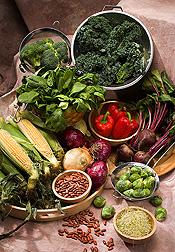Forum—Wasted Food: What We Are Doing
To Prevent Costly Losses
Like many other public and private organizations, the Agricultural Research Service is very concerned about how much food goes to waste between farm and fork—both nationally and internationally.
By reducing losses in our food systems, U.S. growers, processors, and others can enhance America’s ability to feed itself and the world. By the same token, slashing waste may provide new opportunities to reduce costs along the entire supply chain and make better use of increasingly limited natural resources.
The U.S. Department of Agriculture’s Economic Research Service (ERS) estimated—in 2008—that the amount of food lost annually at just the retail and consumer levels alone averaged 275 pounds per person, representing a total yearly national impact of $165 billion. Cutting our food losses by just 15 percent would provide enough extra food to feed more than 25 million Americans every year from existing crop, pasture, and rangelands.
Another ERS assessment found that most of the food loss in developed countries happens postharvest, that is, after food has left the farm gate, while in less developed countries, the bulk of the loss occurs before harvest.
In the United States, nonprofit organizations concerned with a stable and accessible food supply—and wise use of the resources that are needed to produce and deliver that food—have called on the federal government to conduct a comprehensive study of losses in our food systems and to set national goals for reducing this waste. Meanwhile, ARS scientists at laboratories throughout the country have, for some time, been conducting a range of studies to create new technologies or to newly apply existing ones to curb food waste.
Our ongoing work encompasses a wide variety of foods, from grains to grapes, meats to potatoes, and more.
For example, we have developed an ozone-based treatment that growers of organic grapes can use—after harvest—to inhibit Botrytis cinerea, the microbe that causes gray mold. The research provides an alternative to sulfur dioxide, which organic growers cannot use.
We are investigating the combined use of refrigeration, improved packaging, and a natural compound that delays ripening to help perishables such as strawberries, blueberries, and tomatoes stay fresh longer during shipping and storage.
We are developing powdered fruit- and vegetable-based coatings to inhibit spoilage of fresh-cut produce.
We are experimenting with the use of cold plasma technology to ionize the atmosphere inside packages of raw chicken breasts to quickly, safely, and effectively extend the shelf life of this popular product.
We are inventing robots for in-orchard culling of apples, a high-tech approach that could help reduce the postharvest spread of insects or crop diseases from one apple to the next.
We are working to identify storage conditions that will minimize spoilage and losses in new food products such as “microgreens.” These are greens—from daikon radish, buckwheat, or broccoli, for example—that are harvested when they are very young and very small.
We have designed a new package that reduces moisture loss and doubles the storage life of small fruits.
We are designing new and improved retail-display cases to help extend the shelf life of fresh and fresh-cut produce.
In collaboration with the U.S. Centers for Disease Control and Prevention and other cooperators, we are developing sophisticated near-infrared spectroscopy techniques to detect very low levels of insects, toxin-producing molds, and other contaminants that can ruin wheat and other grains during storage.
Some of our investigations target the needs of people in less-developed countries. For instance, we developed the technology for a superior instant corn-soy blend. Twenty metric tons of this ready-to-eat emergency-aid food were shipped to Haiti in 2011 to feed more than 3,000 malnourished children. The product’s 1-year shelf life makes it ideally suited for tropical countries that lack adequate storage facilities.
What’s more, the inexpensive, small-scale processing equipment that we developed has helped Haiti by cutting postharvest losses of locally grown peanuts by about 75 percent and speeding local production of a peanut-butter-based food that is important in preventing malnutrition.
In all, we are eagerly exploring a wide variety of approaches to reduce food waste, and we are continuing to form new partnerships with other researchers and producers in the United States and abroad who share our concern and sense of urgency. We are committed to resolving supply-chain challenges to improve the farm-to-fork flow of wholesome, nutritious food.
Robert L. Fireovid
ARS National Program Leader
Quality and Utilization of Agricultural Products
Beltsville, Maryland
"Forum" was published in the March 2013 issue of Agricultural Research magazine.







